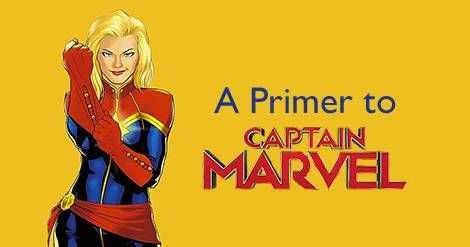
Captain Marvel: A Carol Danvers Primer
This article was updated on July 25, 2017.
After a seemingly endless number of delays, Marvel Studios’ Captain Marvel finally seems on track for a March 2019 release. Brie Larson has been cast in the role for a few months, the Marvel Studios panel at San Diego Comic-Con showed the world our first glimpses of the film’s concept art, and there have been a number of hints that Captain Marvel might first show up in next summer’s Avengers: Infinity War.
But, who is Captain Marvel, and what do you need to read? Whether you are a long-time member of the Carol Corps or just want to see what all the excitement is about, there’s no better time than now to catch up on her adventures before her movie comes out. But, figuring out where to start with Carol’s adventures can be a little intimidating. Fortunately, Book Riot is here to help you find out where to start reading and where to go from there.
Who Is Carol Danvers?
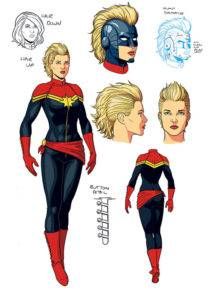
2012 Captain Marvel redesign by Jamie McKelvie
You probably know Carol Danvers as Captain Marvel, but she’s gone by a lot of names over her nearly 50 year career in comics, including Ms. Marvel, Binary, and Warbird. When she first appeared in 1968, Carol was head of security for NASA, where she met the Kree agent Mar-Vell, better known as the first Captain Marvel. After an accident involving an ancient Kree weapon, Carol had her DNA infused with that of Mar-Vell, and she gained super-strength, durability, flight, and a precognitive “seventh sense”. She took the name Ms. Marvel and eventually joined up with the Avengers, until she left the team at the end of Avengers #200, one of the most notorious stories in the title’s history (dubbed by Carol A. Strickland “The Rape of Ms. Marvel“).
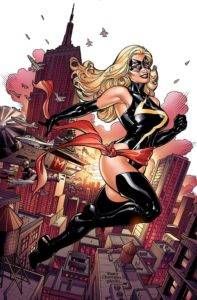
During House of M, Carol briefly became Captain Marvel, one of the Earth’s most popular heroes. The experience inspired her to become “the best of the best.” Variant cover art by Terry Dodson and Rachel Dodson.
When Carol reappeared, she had become the first public victim of then-villain Rogue, who had stolen Carol’s powers and memories. With the help of Charles Xavier, Carol was able to regain her memories, but not her emotional attachment to them. She was living with the X-Men when the team was abducted by the Alien Brood, who experimented on Carol, causing her Kree DNA to manifest again in a new form, that of Binary. In addition to her earlier powers (minus the seventh sense), Carol could also channel cosmic levels of energy from a “white hole”. But, without her emotional attachment to her memories, she found life on Earth difficult (especially after Rogue joined the X-Men), and decided instead to travel the galaxy with the Starjammers.
After a few years, Carol returned to Earth and to the Avengers. Her connection with her white hole broken, however, Carol began to lose her Binary powers, and found herself more and more dependent on alcohol to cope. Following a glimpse of what her life might have been during the House of M event, Carol decided she had been a second-tier hero for too long and tried to make herself the best of the best. In 2012—thirty years after Jim Starlin’s The Death of Captain Marvel, Carol finally took up the title of Captain Marvel herself.
Where to Start
There are two great places to start reading Carol’s adventures: Brian Reed’s Ms. Marvel series (2006-2010) or Kelly Sue DeConnick’s two volumes of Captain Marvel (2012-2013, 2014-2015). While most people in recent years have been introduced to Carol through DeConnick, I would suggest starting with Reed, since you can then proceed directly into DeConnick’s run. But, you can also easily start with DeConnick and then work your way back to Reed later. (If you are already a member of the Carol Corps, then you’ve probably already read DeConnick’s run, making Reed’s the obvious next step.)
Before jumping in, though, a quick note on availability. Marvel has done a poor job of keeping many of Carol’s adventures in print, so you may have trouble finding print copies, depending on current availability. That said, digital is your friend! The vast majority of Carol’s adventures are now available digitally, especially if you are willing to switch back-and-forth between ComiXology and Marvel Unlimited.
Ms. Marvel vol 2 (2006-2010) by Brian Reed and various artists
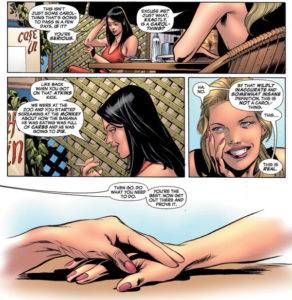
Not quite knowing how far to take something or when to say stop: totally a “Carol Thing.” Ms. Marvel vol 2 #1 (2006), art by Roberto De la Torre and Jimmy Palmiotti.
I was in love with Brian Reed’s Ms. Marvel from issue #1, which uses Carol’s lunch date with Jessica Drew (Spider-Woman) as a framing sequence to talk about her crappy day fighting Stilt-Man and meeting with a new PR agent. The conversation feels organic, and Reed demonstrates very quickly just how well he understands Carol.
Reed’s characterization of Carol throughout the series is spot-on, and he really gets that her addictive personality can take her into some dark, unlikeable places (especially her conduct with Julia Carpenter during Civil War, for which Carol later apologized). But, it also has many moments of pure fun. And, depending on your perspective, you can probably praise and/or blame Reed for most of Carol’s geek bonafides, especially her love of Star Wars. Carol named her cat “Chewie” during Reed’s run, and he wasn’t afraid to have her make jokes like this:
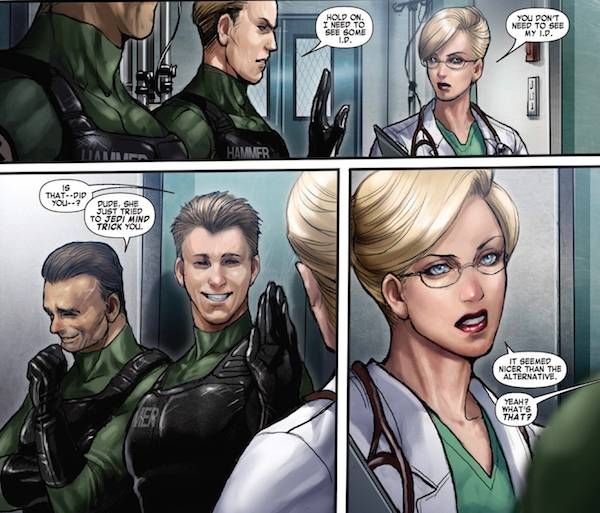
These aren’t the jokes you’re looking for. Ms. Marvel vol 2 #48, art by Sana Takeda.
That said, the run does have some issues, especially on the art front. The covers for about a third of the series (issues 12-30) are by Greg Horn, and are decidedly cheesecakey. This one is probably the worst (though issue #19 gives it a run for its money).
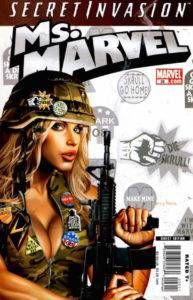
My least favorite Carol Danvers cover of all time. Ms. Marvel vol 2 #29, cover by Greg Horn.
Fortunately, the Horn covers are not indicative of what’s inside the books. While there are a some particularly ill-advised panels scattered throughout the run, it doesn’t approach this level of cheesecake, and some of the artists—notably Sana Takeda, who drew most of the last dozen issues (including the Jedi mind trick panels above)—are quite good. If you can get past the covers, there’s a lot to love here. (That said, you might want to skip over the Puppet Master story in issues #18-20 if human trafficking and rape set off any alarm bells.)
I really love Reed’s Ms. Marvel. It isn’t perfect—especially the art for the first half of the series—but it is a very solid run that set up so much of what makes Carol great today. It is definitely worth reading, just ignore the covers and try not to judge Carol too harshly during Civil War.
Unfortunately, at the time of writing many of the trades are OOP and hard to find, so digital is probably your best best.
Captain Marvel volume 6 (2012-2013) and volume 7 (2014-2015) by Kelly Sue DeConnick and various artists
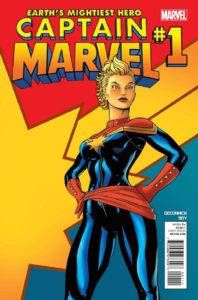
Captain Marvel vol 6 #1, cover by Ed McGuinness.
In 2012, Carol finally got the promotion to Captain Marvel, as well as a new costume designed by Jamie McKelvie and a new series written by Kelly Sue DeConnick, with Dexter Soy initially illustrating.
DeConnick started her run on Captain Marvel quite strong, bringing back some of Carol’s supporting cast that we hadn’t been seen since the ’70s and reexamining her origin as a superhero. She also had a fantastic scene where Carol talks to Monica Rambeau (the ’80s Captain Marvel) about taking the name without talking to her first, a great response/apology to the Monica Rambeau fans who felt like Marvel was erasing a woman of color in favor of a white blonde. After 17 issues, the series relaunched with a “Captain Marvel in space” status quo and with David Lopez on art.
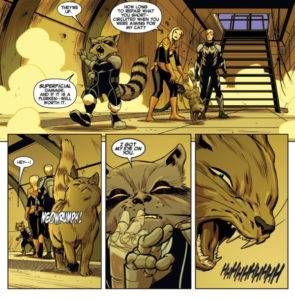
Lopez’s art is wonderfully expressive, even for the non-humanoid cast members. Captain Marvel vol 7 #2, art by David Lopez and Lee Loughridge.
I cannot understate how important DeConnick has been in bringing attention to Carol Danvers. DeConnick leveraged her social media mojo to create/encourage the Carol Corps, a group of real life fans who share their love of Carol Danver online and at conventions. Insofar as people today know who Carol Danvers is, it’s probably because of DeConnick (and we should not downplay DeConnick and the Carol Corps’ role in Marvel’s decision to make a Captain Marvel movie in the first place).
I enjoyed DeConnick’s run overall, and it had some fantastic emotional highs and lows—especially the last issues of each volume—but on a whole I like it slightly less than Reed’s (my main issue with DeConnick’s run centers on the aftermath of The Enemy Within). But, not everyone has loved her series, so if you start DeConnick’s run and don’t like it, you’re not an aberration. You might like something else with Carol more.
In addition to the original trades (now OOP and hard to find), DeConnick’s two volumes of Captain Marvel have been collected in four books under the title Captain Marvel: Earth’s Mightiest Hero. Each book collects about two trades worth of material, so they are a pretty great value. The two volumes, as well as the Secret Wars tie-in Captain Marvel and the Carol Corps, are also available on ComiXology, the Kindle Store, and Marvel Unlimited.
Advanced Studies
Once you’ve read through both Reed’s and DeConnick’s runs, you might want to delve deeper into Carol’s past. If you want to read everything, Peter Marinari has a fantastic reading order/collecting guide on his blog Crushing Krisis, but here are the highlights.
Captain Marvel volume 1 by Roy Thomas and Various Artists (1968-1969)
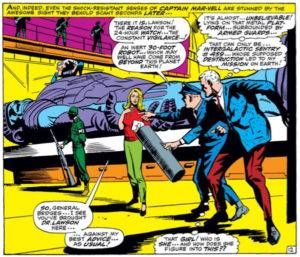
Even in her first appearance, Carol Danvers was a badass. Marvel Super-Heroes vol 1 #13, art by Gene Colan, Paul Reinman, and Stan Goldberg.
As mentioned above, Carol first appeared in Marvel’s first Captain Marvel series, where she was a supporting character through issue #18. She has a few good moments, but is not really the focus and this being a Silver Age comic, she inevitably gets damselled. I would recommend reading her first appearance in Marvel Super-Heroes #12 and #13, as well as her last regular appearance in Captain Marvel #18 (later retconned as the origin of her superpowers), all three of which are on Marvel Unlimited. If you love it, read the rest of Thomas’s run.
Ms. Marvel volume 1 by Chris Claremont, Gerry Conway and various artists (1977-1979)
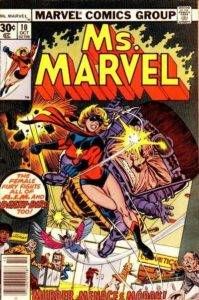
Ms. Marvel vol 1 #10, cover art by Sal Buscema, Tom Palmer, and Irv Watanabe.
Ms. Marvel volume 1 is fascinating, if deeply flawed. Gerry Conway wrote the first two issues, and they have every appearance of being rush jobs. (In fairness to Conway, he was credited as writer for nine comics the month Ms. Marvel #1 came out, though that probably was a sign he shouldn’t have taken the job in the first place.) Conway inexplicably turned Carol into a Gloria Steinem expy, with a job as editor of Woman magazine, published by none other than J. Jonah Jameson. Fortunately, Conway was promptly replaced by Chris Claremont, who had recently started writing the still-bimonthly and not-yet uncanny X-Men.
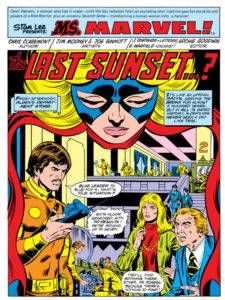
Words cannot express my love for the frame around this splash page from Ms. Marvel vol 1 #8, art by Jim Mooney, Joe Sinnott, and Don Warfield.
Claremont spent most of his first ten issues cleaning up Conway’s mess—revising the origin of Carol’s powers, eliminating her dual personalities, and giving Carol her own supporting cast—while the back half of the series was largely setting up for an epic Ms. Marvel/Mystique smackdown that never occurred due to cancellation.There’s some great late ’70s Claremont in there, but it’s hard to read without getting irritated that Marvel (a) didn’t assign the book to him in the first place and (b) cancelled it just before he was able to pay off months of foreshadowing.
The entire series has been collected in two Marvel Masterworks volumes, which can be quite pricey in print, but are much more affordable digitally. Volume 2 includes Avengers Annual #10 (see below), as well as Claremont’s stellar coda from Marvel Fanfare #24. Oddly, only the first and last issues are currently available on Marvel Unlimited, so you’re best going the ComiXology or Kindle Store route for now.
Avengers Annual #10 by Chris Claremont and Michael Golden (1981)
When Claremont read the notorious rape/pregnancy story in Avengers #200, he was rightly angered at Marvel’s treatment of Carol Danvers and wrote Avengers Annual #10 in response. There, Carol’s powers and memories are stolen by Rogue (in her first appearance). With help from Professor X of the X-Men, Carol recovers her memories, but not her emotional attachment to them. Claremont then gives Carol a chance to brutally take down the Avengers for their callousness before she goes off to live with the X-Men.
The Brood Saga: Uncanny X-Men vol 1 #161-167 by Chris Claremont and David Cockrum (1982-1983)
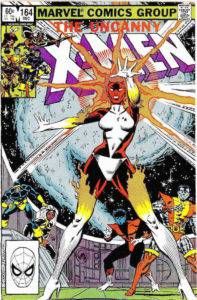
Uncanny X-Men vol 1 #164, cover art by Dave Cockrum and Bob Wiacek.
Avengers Annual #10 might have given Carol a voice, but it simultaneously took away her powers, a move that was itself problematic. Presumably recognizing this, Claremont acted quickly to give Carol a new, unique power set and a new status quo in what would come to be known as the Brood Saga. It’s a genuine classic, so well-worth reading if you like Claremont’s style. Surprisingly, it has never been reprinted in trade, though it is available on Comixology and Marvel Unlimited.
Live Kree or Die by Kurt Busiek and Various Artists (1998)
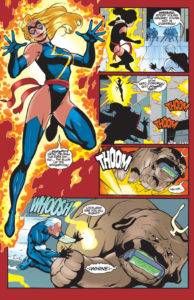
Go home, Carol, you’re drunk. Quicksilver #10, art by Derec Aucoin, Rich Faber, and Joe Rosas.
In 1998, Kurt Busiek and George Perez included Carol in the reformed Avengers in the wake of Heroes Return. Unfortunately, something had gone wrong, and Carol had lost her connection to the “white hole” that powered her Binary abilities, a fact she initially hid from her teammates. Carol has some great moments in the first six issues of the Busiek/Perez run, but the truly essential character development came in the Live Kree or Die crossover in 1998, which ends with Carol quitting the Avengers before she could be court-martialled. The crossover is available in the Avengers Assemble Volume 1 trade paperback (but, oddly, not the hardcover or the Comixology version of the collection). Marvel Unlimited may be your best bet.











